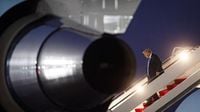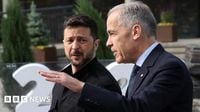President Donald Trump abruptly left the G7 summit in Kananaskis, Alberta, on Monday, June 16, 2025, cutting short his attendance to return to Washington amid escalating tensions between Israel and Iran. His early departure, announced by White House press secretary Karoline Leavitt on X, came shortly after Trump issued a stark warning on Truth Social urging residents of Tehran to evacuate immediately. "Everyone should immediately evacuate Tehran!" Trump wrote, emphasizing his firm stance that "IRAN CAN NOT HAVE A NUCLEAR WEAPON." He lamented that Iran "should have signed the ‘deal’ I told them to sign," calling the situation a "shame, and waste of human life." This message came amid intensifying conflict, with an Iranian strike killing at least eight people in Israel on the same day.
During the G7 summit, Trump initially hesitated to join fellow leaders in signing a joint statement calling for de-escalation between Israel and Iran but reversed his decision after revisions to the draft, according to an anonymous source cited by The Washington Post. The statement affirmed Israel’s right to defend itself and identified Iran as the "principal source" of instability in the Middle East, reiterating that Iran "can never have a nuclear weapon." The G7 leaders urged that the resolution of the Iranian crisis should lead to broader de-escalation across the region, including a ceasefire in Gaza.
Trump’s departure followed a day of significant diplomatic activity. On Monday, he finalized a major trade deal with British Prime Minister Keir Starmer, formalizing adjustments to tariffs agreed upon the previous month. However, the deal did not immediately eliminate the 25% steel tariffs on British imports. Canadian Prime Minister Mark Carney, hosting the summit, announced C$4.3 billion (£3.1 billion) in new support for Ukraine on Tuesday morning, standing alongside Ukrainian President Volodymyr Zelensky, who sought additional sanctions on Russia. Trump, however, expressed skepticism about further sanctions, highlighting ongoing divisions within the summit.
When asked about his early exit, Trump told reporters, "I have to be back as soon as I can," citing "obvious reasons" related to the Middle East crisis. He requested that the National Security Council be ready in the Situation Room upon his return, underscoring the gravity of the situation. Speaking aboard Air Force One en route to Washington, Trump emphasized his desire for a "real end" to the Israel-Iran conflict, not merely a ceasefire. He suggested the possibility of sending Vice President JD Vance and special envoy Steve Witkoff to negotiate with Iranian officials, though he remained noncommittal, saying, "Depends on what happens when I get back. I don't know. I'm not too much in a mood to negotiate."
Trump also defended his earlier warning to evacuate Tehran, clarifying there was no specific threat but that he wanted "people to be safe." He warned that if Iran targeted U.S. assets or troops, the United States would respond forcefully. "I think they know not to touch our troops," he said, adding, "If they do anything to our people, we'll come down so hard. Then the gloves are off so beautifully." This firm stance reflects the administration’s readiness to respond should the conflict escalate further.
The conflict has already exacted a heavy toll. Since Israel’s initial strike on June 13, 2025, targeting several top Iranian military officials, at least 224 people have been killed in Iran, including members of Supreme Leader Ali Khamenei’s inner circle, according to Iranian state media. Retaliatory strikes by Iran have killed at least 24 people in Israel, with thousands of Israeli residents evacuated due to ongoing attacks, as confirmed by Israeli Finance Minister Bezalel Smotrich. The U.S. Embassy in Jerusalem and its branch in Tel Aviv announced closures on June 16 and 17, respectively, citing security concerns amid the hostilities.
Trump’s abrupt exit from the summit echoes his 2018 departure from the same event, when he left amid tensions with then-Prime Minister Justin Trudeau over a joint communique. This time, however, Trump’s relationship with Canadian Prime Minister Mark Carney appeared more cordial, with both leaders agreeing to pursue a new economic and security deal within 30 days. Nevertheless, the summit struggled to find unity on multiple fronts, including conflicts in Ukraine and the Middle East, complicated by Trump’s overt support for Russian President Vladimir Putin and his imposition of tariffs on several allies.
Speaking alongside Carney, Trump criticized the 2014 decision to remove Russia from the Group of Eight, calling it a "big mistake." He argued Russia might not have invaded Ukraine in 2022 if Putin had remained in the group, noting, "Putin speaks to me. He doesn't speak to anybody else ... he's not a happy person about it." This stance added to the skepticism surrounding Zelensky’s scheduled meetings with G7 leaders and the potential for stronger sanctions on Moscow.
Despite the tensions, the G7 leaders managed to agree on a joint statement calling for de-escalation of the Israel-Iran conflict. French President Emmanuel Macron described Trump’s departure as "positive," given the objective to achieve a ceasefire. Macron revealed that an offer had been made to meet and exchange views to kick-start broader discussions, emphasizing the need to see whether both sides would follow through.
As the summit continued without Trump, Canadian Prime Minister Carney stressed that work must go on. Zelensky pushed for more sanctions on Russia, while Trump’s absence shifted much of the world’s attention to Washington and the White House’s plans for the Middle East crisis. Trump was scheduled to meet with Ukrainian President Zelensky and Mexican President Claudia Sheinbaum Pardo on June 17 but missed those meetings due to his early departure.
Back in Washington, Secretary of State Marco Rubio accompanied Trump, signaling the administration’s heightened focus on the conflict. Officials from the White House and the Pentagon clarified that U.S. forces in the region would remain in a defensive posture and are not expected to join Israeli offensive operations. However, the administration is poised to respond decisively if American personnel or assets are targeted.
Trump’s warning to evacuate Tehran, while lacking details, underscored the administration’s concerns about the potential for intensified military action. The president’s repeated assertion that "IRAN CAN NOT HAVE A NUCLEAR WEAPON" reflects longstanding U.S. policy, and his frustration that Iran did not take advantage of the 60-day window he offered to negotiate a new nuclear deal. "I gave Iran 60 days, and they said, well, at the 61st, you saw what happened," Trump said, referring to the recent escalation.
As the G7 summit wrapped up, the focus remains on the unfolding crisis in the Middle East. The stakes are high, with the potential for broader regional instability and global repercussions. Trump’s early departure and urgent messaging highlight the administration’s intent to take a leading role in navigating the conflict’s next phases, while the international community watches closely for signs of de-escalation or further escalation.


